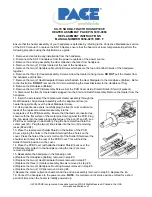
How this affects cutting performance
Benefits of Frequently Changing Blades
P
ROPERLY
S
HARPENED
T
EETH
During the cutting process, the cutting surfaces, both the face and the edge, become blunt and this means that the blade is
“chewing” its way through the wood, instead of cutting, and this results in;
It is better to change the blades more frequently than less frequently.
As soon as the operator notices the performance of the blade deteriorating the operator should change the blade.
Slower feed rates.
Heating of the blade and loss of blade tension
Higher horse power and fuel consumption from the engine.
Blade costs.
Energy costs.
General Maintenance costs.
Daily production.
Quality of the surface finish.
Accuracy of the cut.
Poor surface finish of cut.
Wavy cuts.
Accelerated formation of gullet cracks.
Accelerated formation of cracks on the back of blade caused by the blade being pushed back
against rear flange of the blade guide roller.
Significant reduction in:
The benefits of changing a dull blade, rather than just keeping on cutting are;
Significant improvements in:
















































